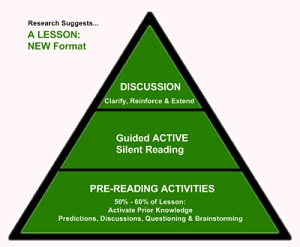The Importance of Pre-reading Activities
Posted by PLB · Leave a Comment

 Recent research brought to light a new lesson format that gave due importance to pre-reading activities. It was found that what is done before reading, is very beneficial for understanding the text. This preparation work is what helps students get connect the new information to what they already know.
Recent research brought to light a new lesson format that gave due importance to pre-reading activities. It was found that what is done before reading, is very beneficial for understanding the text. This preparation work is what helps students get connect the new information to what they already know.
This new format suggests that 50-60% of the lesson should be spent on pre- reading activities (the base or the largest part of the triangle).
These activities are often fun for both the teacher and student.
Sample pre-reading activities may include:
- Discussing new vocabulary and trying to attach it to something students already know.
- Asking students what they know about the topic and from where that information came.
- Looking at the subtitles and asking students to consider anything they know about them.
- Examining the pictures and captions to learn more about what the text is going to say.
- Checking the graphs and maps to discover how they might add meaning to the text.
- Looking at the bold words.
- Analyzing who wrote the text and the audience for whom it was originally written.
- Reading the entire first paragraph and asking students what they know about the text.
- Reading the last paragraph and asking students what they know about the text.
- Reading the first sentence or first two lines in each paragraph and asking students what they now know about the text.
- Asking students to write a question that they anticipate will be answered in the text.
What are some pre-reading activities that you use in your classroom?
From Professional Learning Board’s online continuing education course for teachers: Reading Across the Curriculum



